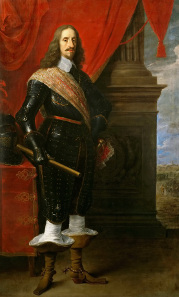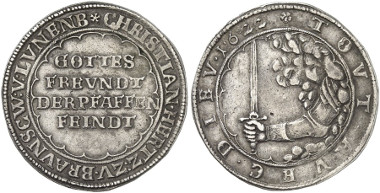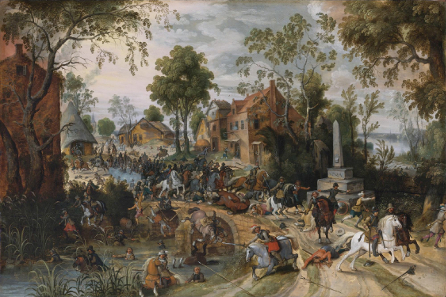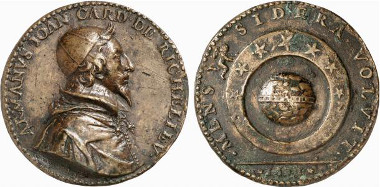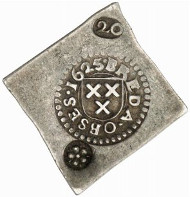translated by Annika Backe
In 1623, Emperor Ferdinand had certainly achieved one his goals: he had got his own way in the Habsburg hereditary lands, to the effect that the Catholic religion became established there. Silesia and Hungary were the only ones that were granted some special rights – Silesia because John George of Saxony, who had assisted the emperor in his conquest, put emphasis on tolerating the Protestants, and Hungary because the emperor was afraid that too harsh a regulation could prompt Bethlen Gabor to react.
David Teniers the Younger, Portrait of Archduke Leopold William of Austria, around 1652. Quelle: Wikicommons.
To avoid jeopardizing this new position of power, Ferdinand streamlined the organization of the Hereditary Lands. The government of the different countries would no longer be divided among all male relatives. Rather, they were to pass to the eldest son. Ferdinand only left Tyrol to his brother Leopold and his heirs in return for Leopold’s undying allegiance.
Siege of Frankenthal 1621. From: Nicolaus Bellus, Österreichischer Lorbeerkranz oder Kayserl. Victorii…, 1625. Source: Wikicommons.
The international situation had changed to the great disadvantage of Frederick V since 1623. He even lost his last territory in the Palatinate because the English king, who wanted to promote a marriage between his heir to the throne and the Spanish infanta, orderd Sir Horace Vere, who had defended the Veste Frankenthal heroically up to that moment, to surrender the city to Spain. By the way, the wedding never took place.
Christian, Bishop of Halberstadt, 1617-1626. Reichsthaler 1622, Lippstadt. Pfaffenfeindthaler. Auction Künker 249 (2014), 965. These silver coins were struck from the church silver Christian had taken from the looted treasure of the Paderborn Cathedral.
Christian of Halberstadt and his army had retreated to his old home, the Lower Saxon Circle, where he then tried to find his troops a new task. Strictly speaking, the princes of this circle were not keen on revolting against the Emperor. They would have preferred to remain neutral but the ‘mad Halberstadter’ forced them to acknowledge him as protector. Together with his troops he settled in the territory of his reluctant elder brother and called on Mansfeld to join him.
Before Mansfeld had the chance to do so, Tilly and the imperial army marched across the border of the Lower Saxon Circle on 13 July 1623. To Ferdinand, transferring the war zone to the north of the empire seemed a good opportunity to expand his influence into that direction.
Sebastian Vrancx, The Battle of Stadtlohn, 1623. Source: Wikicommons.
Christian of Halberstadt who did not consider his army strong enough to stand up against the imperial troops wanted to withdraw but Tilly caught him and crushed Cristian’s army outside a village called Stadtlohn. Devoid of his army and any provisions, Christian of Halberstadt sought refuge at the imperial court of Frederick V, to never play a part in history again.
What he did leave, however, was a problem that prolonged the Thirty Years’ War for another few years. When he retreated, Christian abdicated from office as Protector of Halberstadt in favor of the son of the Danish king. A number of Catholic and Protestant princes had already cast an eye at this see. Ferdinand would have loved to make sure that it passed to Leopold, his second son. He was not the only one interested in this lucrative prebend, though. John George, Elector of Saxony, wanted to win Halberstadt for his family, just like Maximilian of Bavaria and – the king of Denmark.
In the meantime, Frederick V concluded an armistice with Emperor Ferdinand. That might have instigated a peace treaty had it not been for England and France taking over Frederick’s cause.
England had to face the fact that the Spanish wedding was off the table. That was why it was afraid the Spanish might win their fight against the Dutch. In that case, the Habsburgs would have controlled one of the coasts in the English Channel again, which might have compromised the English trade. Mansfeld, who had travelled to the English court, acting as his own troops’ agent, talked the king into funding 12,000 of his men, in order to re-capture the Palatinate and hence cut off the Spanish fighting in the Netherlands from their supplies.
France. Louis XIII. Cast bronze medal 1631, of J. Warin, on Cardinal Richelieu, the secretaries and the closest advisers of the King. Auction Künker 138 (2008), 5622.
In France, Cardinal Richelieu had ascended to power. In co-operation with Pope Urban VIII, he managed to form a coalition of Catholic and Protestant parties that planned to transfer the war against the Spanish Habsburgs to the Rhine and to Northern Italy. In the winter of 1624, Protestant Grisons blocked the Valtelline. In the spring of 1625, the Duke of Savoy led an army, financed by French money, to Upper Italy and besieged Genoa. The Spanish army, therefore, was cut off from all its supplies all of a sudden.
Breda. Uniface silver coin with the face value of 20 stüver, struck during the siege, 1625. Auction Künker 143 (2008), 1221.
To achieve one more success before the shortage of supplies could tip the scales of war for good, Ambrogio Spinola decided to besiege the city of Breda in 1625. Breda was forced to surrender on 5 June 1625, despite the efforts of the recently appointed successor of Maurice Prince of Orange, who had died shortly before, to relief the city.
By that time, Ferdinand had come to realize that he could not count on much financial and military help from his Spanish relatives in this time of distress. Hence, he had to look for other options. Albrecht of Wallenstein, one of the Catholic tycoons of Bohemia who had recently moved upwards, had offered the Emperor to fund and equip an army of 50,000 men, given the Emperor was willing to meet the costs of the soldiers’ pay.
Ferdinand thought that he had almost nothing to lose with this offer. Maximilian of Bavaria was more skeptical. A powerful military commander, loyal only to the Emperor, might have rendered the army of the Catholic League under the command of Tilly less significant. Maximilian followed through with the preliminary number of soldiers being reduced to 20,000 and himself, as leader of the League, staying supreme commander of the imperial troops.
Albrecht of Wallenstein, 1623-1634, Duke of Friedland. Reichsthaler 1627, Jicin. Auction Künker 254 (2014), 3955.
The first joint goal of the armies of Tilly and Wallenstein were the Hanseatic cities in the north which the Spanish wanted to get under their control in order to establish a second supply route in case the Rhine line could not be held any longer. Naturally, France and England wanted to prevent this from happening. They looked for a military commander to advance against Wallenstein and Tilly. One possible candidate was Gustavus Adolphus of Sweden. He had just concluded an armistice with Poland and was not averse to intervening in the German conflicts. Yet his financial demands were so high that neither the French nor the English quickly agreed on paying the price. After a few weeks of negotiating, Gustavus Adolphus thus resumed his war against Sigismund of Poland on 11 July 1625 and was no longer available for defending the Protestant faith.
Christian IV of Denmark. Speciesthaler, 1623, Glückstadt. Auction Künker 176 (2010), 5574.
England and France consequently aligned with Christian of Denmark who, in his capacity as Duke of Holstein, belonged to the estates of the Holy Roman Empire. Christian had founded the city of Glückstadt in his duchy in 1617, in order to compete with Hamburg, in terms of commerce. In 1620, he had his new city strongly fortified to the effect that Glückstadt, under Marquart Rantzan, managed to hold its ground, in contrast to the rest of Schleswig-Holstein that was being occupied by imperial troops and all other fortified places being captured.
Christian wanted to secure the See of Halberstadt for his son, in whose favor Christian, Protector of Halberstadt, had waived his claim. Additionally, the Danish king cast an eye at the Diocese of Osnabrück whose protector had recently died so that this lucrative office was likewise vacant. To justify his intervention in the north, Christian of Denmark pointed out that the Lower Saxon Circle – albeit somewhat reluctantly – had elected him commander-in-chief and not Christian of Halberstadt.
You can read about the repercussions of Christian of Denmark’s intervention in the next episode.
You can find all parts of our series here.





